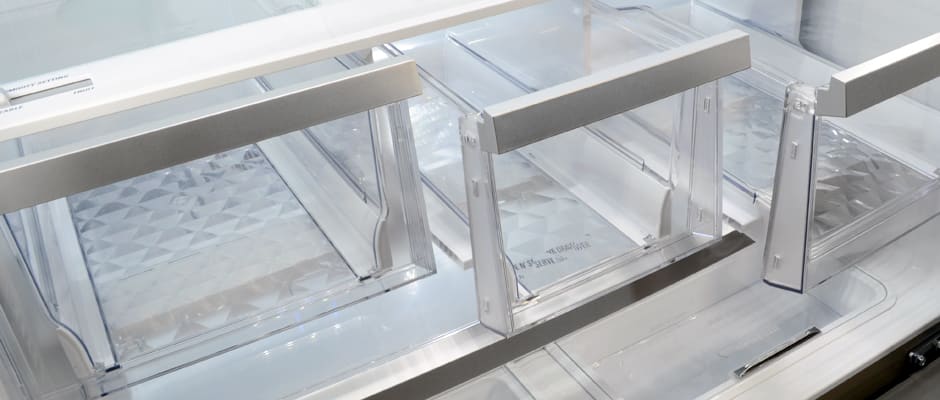Introduction
Design & Usability
Modern age elegance.
With a smooth stainless steel finish, bright LED lighting that saves space, and drawers that glide like they've only just been recently greased, there's no denying that this is an attractive and user-friendly fridge. Compared to other models like the Blast Chiller, which is marketed at 31 cubic feet, the storage increase isn't outrageously noticeable, but it is definitely present. So present, in fact, that consumers may notice this fridge sticking out further into their kitchen than is generally expected. A depth of 37" including handles means this will protrude almost a full foot past an average 26" counter top.
That said, food access should never prove to be a problem despite the added depth: retractable shelves, wide open spaces, and those aforementioned drawers make getting to any corner of the fridge's interior a breeze. Our biggest complaint with this fridge's design is actually the control panel: it's very tall, very prominent, and nearly identical to what we saw on the LFX31925ST over a year and a half ago. The perpetually visible labels detract from the uniform smoothness of what would otherwise have been a flawless fridge exterior. Fortunately, the touch panel element boasted an improved level of responsiveness that somewhat soothed our irritation.
{{photo_gallery "Front", "Fingerprints", "Handle", "Ice Water Dispenser", "Ice Water Dispenser Controls", "Controls", "Fridge", "Water Filter", "Crisper Drawer", "Slide N Hide", "Left Door", "Ice Maker", "Right Door", Freezer", "Side", "Back"}}
Performance & Features
The space may draw you in, but the performance may not be able to keep you around.
Given our past experience with LG's pricey French door models, we set some pretty steep expectations for the LFX33975ST. While it's not perfect—added storage means more space for air to circulate, something that can detract from consistency both over time and space—this fridge is still a high-quality product that shouldn't disappoint... though it's worth mentioning that the Blast Chiller model, while smaller, has superior performance.
The fridge compartment ran just ever so slightly too warm, but only by about one to one and a half degrees. Conversely, the freezer ran just a hair under zero, something which may make the fridge work harder than it needs to. This sort of inconsistency is easy to correct by just adding or subtracting a degree as needed, but you shouldn't have to calibrate a darn thing on a $3,500 refrigerator. Our other major performance test—humidity retention in the crisper drawer—was a bit disappointing. Results were below average, meaning you'll want to use fresh fruit and produce within a few days of purchase, otherwise you may start to notice a decline in quality that's faster than you'd expect from a refrigerated item.
Despite any performance quibbles that we may have had, this fridge manages to include a number of interesting and surprisingly practical features. The wide "Glide N' Serve" drawer in the fridge serves up three different temperature settings—Meat, Deli, and Produce—while the two "Slide N' Hide" compartments on the bottom make for unexpectedly useful storage. The glass lid is heavy enough that it slides like a drawer, while light enough to remove for easy cleaning. The external water and ice dispenser performs without a hitch, but actual usage could be troublesome. Since water comes out of a spout on the front, the little niche isn't helpful; filling a gallon jug can get tricky if you're not prepared to hold it for a while.
Conclusion
A luxury purchase difficult to justify for practical consumers lacking large families.
The LG LFX33975ST is big. Very big. Bigger than any fridge we've ever tested, and one of the largest consumer fridges on the market right now. That said, size isn't everything: the added storage makes it harder for this model to deliver even performance. With a whopping $3,500 price tag, consumers should expect—and demand—perfection, something this fridge doesn't deliver. Now, with that said, it's still a product that outperforms a rather large number of competitive models.
If LG decides to drop the price, and you've got both the kitchen space and the need to store large amounts of fresh food (we're looking at you, Octomom), then maybe it would be worth your while. Most households that don't host holiday parties of 50 or more probably don't need a 33 cubic foot fridge, however, and would likely be fine with a smaller—and cheaper—model. With online prices currently hovering, at best, around $3,055, our best advice is to balance need with desire, and just play the waiting game to see if you can get one when a sale hits.
Introduction
While the numbers behind the LFX33975ST don't necessarily serve up what we were expecting to be the third in an unbroken line of top-ranking LG French-door fridges, it's still an exceptional model. In fact, if the MSRP were even $1,000 less, we'd probably be telling people to run out and buy one as soon as you finished reading this sentence. Unfortunately, the largest fridge we've ever tested happens to be one of the most expensive ones, too, and our test data paints a picture that you should consider carefully before making such a sizable investment.
Temperature Performance
In a vacuum it would be good, but not what we'd expect from a $3,500 fridge.
The refrigerator averaged 38.61 degrees throughout the entire cavity, with the lower portion running about two thirds of a degree warmer (actually a good thing, since produce should be stored at a slightly higher temperature that other refrigerated goods like milk and yogurt). The thermostat, however, was calibrated to the ideal temperature of 37 degrees. What that could mean is that the air temperature may have reached 37, but that level of coolness wasn't penetrating to the center of our test materials. The solution? Just turn down the thermostat to 36 degrees instead. It's crude but effective; that said, it's not something consumers should have to do with a fridge that costs as much as (or more than) 10% of the annual salary for many consumers. Equally disappointing was the average temperature shift of 0.68 degrees over time. We've seen worse, but again, we're talking about a $3,500 fridge here, and unlike the thermostat, consistency is a problem which consumers can't fix.
The freezer wasn't quite as disappointing, though its inaccuracy is still rather troubling. Set to zero degrees, it clocked in at -0.45 degrees. You may be asking yourself "Wait, that's only half a degree off. What's the problem?" The problem is that we saw an average low of -2.5 and an average high of 1.7, with more regular shifts of 0.34 degrees over time. Again, it's not awful, but it's not as consistent as we'd like for something this expensive. Freezer burn may be a problem for items that have been in cold storage for a long time, but short term freezing shouldn't exhibit too much of an impact.
{{photo_gallery "Fridge Temperature", "Fridge Temp Graph", "Freezer Temperature"}}
Moisture Retention
33 cubic feet that you probably shouldn't be filling with produce.
The weakest link in our battery of tests proved to be the LG's crisper drawer. With exceptional opening and closing smoothness, clear glass and plastic viewing, and a hefty humidity switch, we were counting on top-notch results. Unfortunately, our test materials lost an average of 0.21 grams of water per hour over the course of three days. That's definitely below average, a rate that could result in spoiled produce and wasted money if you don't eat what you buy quickly enough.
Freezing & Thawing
Surprisingly effective freezing for such a large cavity.
Large freezers typically mean long freezing times... but not in the case of this LG. Our room-temperature test materials took an average of one hour and 36 minutes to reach a frozen state. Typically with freezers this large, we're lucky to see a freezing time of one hour and 45 minutes. While this LG isn't the fastest we've ever seen, it's fast enough that your meat, fish, and other frozen goods should retain most of their original quality and texture.
Part of LG's ability to increase storage size is the use of more efficient—meaning thinner—insulation. Despite the reduction in insulation size, it still does its job perfectly. After unplugging the LG for 36 hours, everything inside the freezer was still thoroughly frozen. We imagine it could have gone on for at least another 12 hours easily.
{{photo_gallery "Freezing Graph", "Power Loss Graph"}}
Storage Space & Energy Efficiency
One of the largest fridges around, and—oddly enough—one of the most efficient.
The storage capacity in this LG isn't as monumental as you might think, but it is surprisingly honest. LG's Blast Chiller fridge was marketed at 31 cubic feet compared to this model's 33. We measure for usable space, however, subtracting potential storage that's blocked by shelves, lights, water filters, and the like. The Blast Chiller clocked in at just under 19 cubic feet worth of actual, usable storage, while this model added about one and a half cubic feet more. That's actually a very acceptable and proportional increase in size, and while it may not sound like much, one and a half cubic feet of pure food is pretty darn impressive.
To break down those numbers a bit, let's first look at the fridge proper. With four half-width rear-mounted shelves, a full width shelf, two humidity-controlled crispers, a third deli drawer, the "Glide N' Serve" temperature controlled drawer, and the two "Slide N' Hide" bins—_Phew!_—this fridge has tons of varied storage options. Throw in the thin shelves on the left door—which also houses the ice maker—as well as the dairy bin and assorted shelves on the right door—two of which can hold multiple gallon-sized jugs—and you've got an massive 14.12 cubic feet of fresh food storage. The freezer is a little simpler, with only a pull-out drawer, a sliding shallow tray perfect for storing frozen pizzas and TV dinners, and a deep bucket divided by a movable partition. That said, it still amounts to an equally impressive (for a freezer) 6.33 cubic feet of usable space.
{{photo_gallery "Fridge Storage", "Left Door Storage", "Right Door Storage", "Freezer Storage"}}
Despite all this extra space, you shouldn't see a major shift in your electric bill compared to what you'd spend on other, slightly smaller models. Using an average price point of $0.09 per kWh, our power meters indicated that you would have to spend $60.75 per year to operate this gargantuan appliance. That means each cubic foot of usable space is consumer about 0.09 kWh each, actually a fairly efficient number. Keep in mind that power numbers like these typically take the ice maker into account. In fact, we ran this test twice to measure the difference: with the ice maker turned off, you'd see that annual cost drop to about $32 per year, a pretty substantial difference.
Meet the tester
Matthew is a native of Brockton, MA and a graduate of Northeastern, where he earned a degree in English and Theatre. He has also studied at the Gaiety School of Acting in Dublin and spends most of his free time pursuing a performance career in the greater Boston area.
Checking our work.
Our team is here for one purpose: to help you buy the best stuff and love what you own. Our writers, editors, and lab technicians obsess over the products we cover to make sure you're confident and satisfied. Have a different opinion about something we recommend? Email us and we'll compare notes.
Shoot us an email


